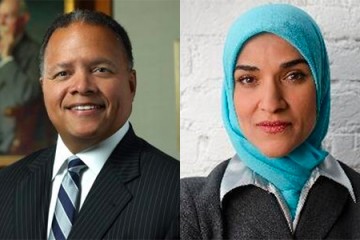More than 70 Johns Hopkins University doctoral program directors gathered Monday at the university's Homewood campus for a workshop centering on methods of recruiting, enrolling, and retaining a diverse graduate student body.
In his introductory remarks, JHU Provost Sunil Kumar underscored the urgency of building a diverse student body and said he would like to see more progress. He illustrated his point with student body composition data collected for the JHU Roadmap on Diversity and Inclusion, a comprehensive document on the university's diversity efforts that is expected to be released later this week. JHU's full-time graduate student body in the fall 2016 semester included 9.5 percent underrepresented minorities—up from 8 percent 2008.
"Some of you face small numbers [of applicants] and pipeline issues, et cetera, which explains some of the variation," Kumar said. "But rather than simply rationalizing away our composition data, we felt that we should look at the best practices and try to break through the log jam."
Keynote speaker Freeman Hrabowski, president of the University of Maryland Baltimore County and former chair of the President's Advisory Commission on Educational Excellence for African Americans, also suggested taking a hard look at university enrollment data to understand areas for improvement.
"Look at the data. Use analytics," he said. "Be dispassionate and don't focus on anecdotes, but rather, look at the whole picture.
"I would argue that you need to think about an ecosystem when you think about diversity," Hrabowski added "... As you think about how to increase the number of students from different backgrounds at the grad level, it's important to think about what's happening at the undergrad level, what's happening at the faculty level, even what's happening with staff members—what is the culture for people who are different in that department?"
A panel of speakers discussed successful strategies that have led to the recruitment and retention of students from diverse backgrounds at Johns Hopkins. The panel included Namandje Bumpus, associate dean for institutional and student equity for the School of Medicine; Jeff Gray, a professor in the School of Engineering; Marie Nolan, executive vice dean for the School of Nursing; and Mark Van Doren, a professor in the School of Arts and Sciences.
The panel advocated eliminating artificial barriers to admission for students with disabilities, students from underrepresented minority groups, and students from underprivileged economic backgrounds. These barriers, they explained, could include test scores, coursework requirements, or clinical experience requirements that may not be accessible for all students.
The panel also advocated a holistic approach to reviewing applicants—such as calling professors who wrote letters of recommendation to understand the full scope of a student's abilities or clarify assumptions that could be informed by unconscious bias.
The workshop was sponsored by the provost's office and developed by Kelly Gebo, the vice provost for education; and Janet Schreck, the assistant vice provost for education.
"We are committed to diversity across all levels of the university," Schreck said. "We want our directors to be excited about this idea of taking a hard look at Johns Hopkins' graduate student population, determining what our current challenges are, what strengths we can build upon, and the action plan steps we must develop moving forward."
Posted in University News
Tagged diversity









